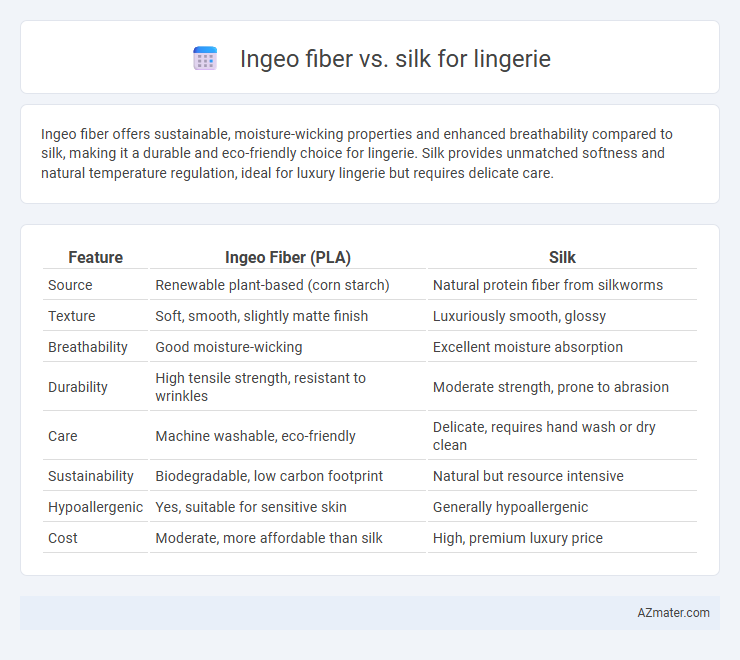Ingeo fiber offers sustainable, moisture-wicking properties and enhanced breathability compared to silk, making it a durable and eco-friendly choice for lingerie. Silk provides unmatched softness and natural temperature regulation, ideal for luxury lingerie but requires delicate care.
Table of Comparison
| Feature | Ingeo Fiber (PLA) | Silk |
|---|---|---|
| Source | Renewable plant-based (corn starch) | Natural protein fiber from silkworms |
| Texture | Soft, smooth, slightly matte finish | Luxuriously smooth, glossy |
| Breathability | Good moisture-wicking | Excellent moisture absorption |
| Durability | High tensile strength, resistant to wrinkles | Moderate strength, prone to abrasion |
| Care | Machine washable, eco-friendly | Delicate, requires hand wash or dry clean |
| Sustainability | Biodegradable, low carbon footprint | Natural but resource intensive |
| Hypoallergenic | Yes, suitable for sensitive skin | Generally hypoallergenic |
| Cost | Moderate, more affordable than silk | High, premium luxury price |
Introduction to Ingeo Fiber and Silk
Ingeo fiber, derived from renewable plant-based materials like corn, offers sustainable, breathable, and moisture-wicking properties ideal for lingerie. Silk, a natural protein fiber produced by silkworms, is prized for its luxurious softness, sheen, and excellent temperature regulation. Both fibers provide comfort and elegance, but Ingeo's eco-friendly production sets it apart in sustainable lingerie options.
Origins and Production Processes
Ingeo fiber, derived from renewable plant-based materials like corn, undergoes a biopolymer process converting starch into a biodegradable fiber, emphasizing sustainability and lower environmental impact. Silk, obtained from silkworm cocoons, involves labor-intensive sericulture and reeling methods rooted in traditional practices, producing a natural protein fiber known for its luxurious texture. The production of Ingeo fiber prioritizes eco-friendly technology and resource efficiency, contrasting with silk's centuries-old artisanal techniques relying on animal agriculture.
Eco-Friendliness and Sustainability
Ingeo fiber, derived from renewable corn starch, offers superior eco-friendliness compared to silk, which requires extensive mulberry cultivation and silkworm farming impacting biodiversity. Ingeo's low carbon footprint and biodegradability enhance sustainability credentials, whereas silk production involves significant water usage and pesticide application. Choosing Ingeo fiber for lingerie supports reduced environmental impact and promotes circular fashion practices.
Comfort and Skin Sensitivity
Ingeo fiber offers exceptional breathability and moisture-wicking properties, making it ideal for lingerie designed for sensitive skin and all-day comfort. Silk provides a luxurious, smooth texture with natural hypoallergenic qualities, but may require more delicate care. Both fibers promote softness against the skin, yet Ingeo's sustainable origin and enhanced moisture management give it an edge in comfort and skin sensitivity for lingerie.
Moisture-Wicking and Breathability
Ingeo fiber offers superior moisture-wicking properties compared to silk, effectively drawing sweat away from the skin to keep the wearer dry and comfortable. Its breathable structure enhances airflow, reducing heat buildup during prolonged wear, which is ideal for lingerie. Silk, while naturally breathable, retains more moisture and dries slower, making Ingeo fiber a more performance-oriented choice for moisture management and breathability in intimate apparel.
Durability and Longevity
Ingeo fiber, derived from renewable plant resources, offers impressive durability and resistance to wear, making it suitable for lingerie that maintains shape and softness over time. Silk, a protein fiber, provides a delicate and luxurious feel but is more prone to abrasion and requires careful maintenance to preserve its longevity. When comparing longevity, Ingeo fiber outperforms silk in sustaining structural integrity under frequent use and washing.
Aesthetics and Visual Appeal
Ingeo fiber offers a smooth, matte finish with a subtle sheen that enhances the natural curves of lingerie, providing a modern and eco-friendly aesthetic. Silk boasts a luxurious luster and fluid drape that creates an elegant, timeless visual appeal, often associated with high-end intimacy wear. Both fibers deliver distinct textures and finishes, with Ingeo appealing to sustainable fashion enthusiasts and silk favored for its classic richness and softness.
Cost Comparison and Accessibility
Ingeo fiber offers a more cost-effective alternative to silk for lingerie, with prices typically 30-50% lower due to its renewable, bio-based production process. Silk remains less accessible because of its labor-intensive harvesting and limited geographic cultivation, resulting in higher market prices and seasonal availability constraints. Consumers seeking affordable and sustainable lingerie options increasingly prefer Ingeo fiber for its balance of performance, affordability, and ecological benefits.
Care and Maintenance Guidelines
Ingeo fiber lingerie requires gentle machine washing or hand washing in cold water to maintain its shape and softness, avoiding bleach and high heat drying to prevent fiber damage. Silk lingerie demands delicate hand washing with mild detergent or professional dry cleaning, avoiding prolonged exposure to sunlight and rough fabrics to preserve its natural luster and strength. Both fabrics should be air-dried flat or hung in the shade to ensure longevity and maintain the integrity of the delicate fibers.
Choosing the Right Fabric for Your Lingerie
Ingeo fiber, derived from renewable plant-based materials, offers breathable, moisture-wicking properties and a soft, lightweight feel ideal for sustainable lingerie. Silk, known for its natural sheen, smooth texture, and temperature-regulating qualities, provides luxurious comfort and elegant aesthetics. Choosing between Ingeo and silk depends on whether you prioritize eco-friendly performance and durability or classic luxury and silky softness in your lingerie.

Infographic: Ingeo fiber vs Silk for Lingerie
 azmater.com
azmater.com